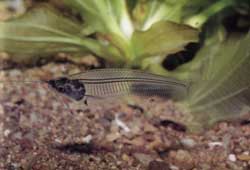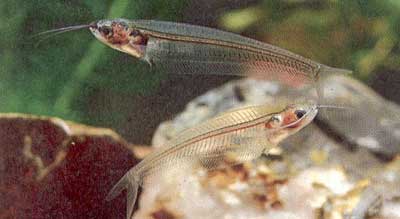The glass catfish, Kryptopterus bicirrhus, has a shimmering body that allows for a clear view of its internal organs, as its entire body is nearly transparent. The male reaches a body length of nearly 10 centimeters.
 Its dorsal fin is so small that it appears as a thin line. The fish has tightly packed teeth and long whiskers (also known as glass catfish). They live in schools in the mid-water layer, rarely found alone at the bottom of rivers or lakes like other whiskered fish species. They primarily feed during the day, consuming small invertebrates such as water beetles and larvae.
Its dorsal fin is so small that it appears as a thin line. The fish has tightly packed teeth and long whiskers (also known as glass catfish). They live in schools in the mid-water layer, rarely found alone at the bottom of rivers or lakes like other whiskered fish species. They primarily feed during the day, consuming small invertebrates such as water beetles and larvae.
When sleeping, this species of glass catfish suspends itself in the water, with the lower part of its tail fin resting on the river or lake bottom.
The small glass catfish that inhabit the mid-water layer are at significant risk of becoming prey for larger fish. However, glass catfish have a unique defense mechanism: they gather in small groups, and the transparent bodies of individual fish blend together within the school. This confuses predatory fish, making it difficult for them to identify individual glass catfish, thereby complicating their attacks.
Kryptopterus bicirrhus is found in freshwater rivers and lakes in Malaysia and Indonesia, where they spawn in freshwater, and the eggs hatch after 2 to 3 weeks.



















































